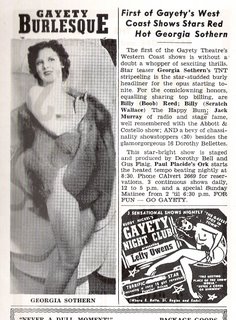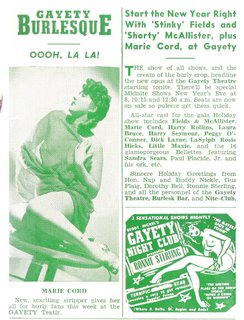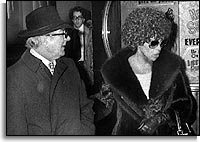 While we've all heard of Hugh Hefner's famous girlie mag, Baltimore's Playboy Magazine (shown left) is relatively unknown. Alternately known as This Week In Baltimore: The Playboy Magazine or The Playboy Presents: This Week In Baltimore (with the subheading "In the Land of Pleasant Living, The Magazine of Baltimore City, The Surrounding Counties & Seashores of Maryland, and Delaware Nite-Life"), it appears to have been a events calendar that was published from November 1, 1947 (pre-dating Hefner's December 1953 Playboy debut by a dozen years) through the late 60s by one Bernie Lit, who also wrote its main column "Baltimore Nite-Life" (subheaded "MEN, MAIDS and MISScelaneous LITerature) and advertised in its pages looking for new talent ("TOPlus Go Go Girls Wanted") for the "Bernie Lit Theatrical Agency" of Water Steet. The magazine's logo (which was also used to illustrate Bernie Lit's column) was a drawing of a tipsy "Man About Town" dandy in a tux and tophat who steadied himself with a walking stick in one hand while his other arm was wrapped around a lampost (as pictured above left).
While we've all heard of Hugh Hefner's famous girlie mag, Baltimore's Playboy Magazine (shown left) is relatively unknown. Alternately known as This Week In Baltimore: The Playboy Magazine or The Playboy Presents: This Week In Baltimore (with the subheading "In the Land of Pleasant Living, The Magazine of Baltimore City, The Surrounding Counties & Seashores of Maryland, and Delaware Nite-Life"), it appears to have been a events calendar that was published from November 1, 1947 (pre-dating Hefner's December 1953 Playboy debut by a dozen years) through the late 60s by one Bernie Lit, who also wrote its main column "Baltimore Nite-Life" (subheaded "MEN, MAIDS and MISScelaneous LITerature) and advertised in its pages looking for new talent ("TOPlus Go Go Girls Wanted") for the "Bernie Lit Theatrical Agency" of Water Steet. The magazine's logo (which was also used to illustrate Bernie Lit's column) was a drawing of a tipsy "Man About Town" dandy in a tux and tophat who steadied himself with a walking stick in one hand while his other arm was wrapped around a lampost (as pictured above left). Other columns in the 32-page publication included "Kutting Kapers--With Kenny" (subheaded "Glorified Nite-Life Potpourri"), a featured stripper listing entitled either "Where the Girls Are" or "For Men Lonely...," a featured singer/musician listing entitled either "Where the Boys Are" or "For Women Lonely...," and "This Week In Baltimore County" (as well as other counties rotated on a week to week basis). One 1967 issue even featured an epic poem entitled "Ode to the Man Behind the Bar" by Chuck Hancock, Bar-Host of the Friendship International Airport Lounge-Restaurant.
Other columns in the 32-page publication included "Kutting Kapers--With Kenny" (subheaded "Glorified Nite-Life Potpourri"), a featured stripper listing entitled either "Where the Girls Are" or "For Men Lonely...," a featured singer/musician listing entitled either "Where the Boys Are" or "For Women Lonely...," and "This Week In Baltimore County" (as well as other counties rotated on a week to week basis). One 1967 issue even featured an epic poem entitled "Ode to the Man Behind the Bar" by Chuck Hancock, Bar-Host of the Friendship International Airport Lounge-Restaurant. In the late '40s, Leo Lion wrote the "Moviesense" column, reviewing films currently playing in Baltimore and name-dropping visiting film and theatre stars spotted around town. One of Leo's columns also "lionized" publisher Bernie Lit's charming wife Janis, who ran Bernie's Delicatessen, who was described as "doing her utmost to make you feel at home at 3 A.M. while picking the corned beef out of your teeth." Also, Dundalk and Essex were apparently hep enough 'burb hotspots to warrant a regular column called "Where To Go To Dine and Dance...Music and Fun in Essex and Dundalk" that featured lots of ads for Lambert's Tavern on Middle River road, Lynwood's ("Dancing Every Saturday to the Sophisticats") on Old Eastern Avenue at Wilbur Avenue, "Barn Dancing" at Old Buedel's Park on Old Eastern Avenue, more barn dancing at The Old Mill on Dundalk Avenue at Maryland Turner's Station, Dovie's Supper Club on Stansbury Rd. and Merritt Avenue, Diffendall's Airport Cocktail Lounge on Back River Neck Rd., Hollywood Park Supper Club & Cocktail Lounge ("The Largest Cocktail Lounge in East Baltimore" with two suffleboards and "Blind Pig" Tournaments every Monday night!) on Eastern Avenue and Sealover Brothers Restaurant on Turkey Pt. and Beck Avenue.
There's no price listed on Playboy Magazine, so I suspect it was some sort of touristy promotional events calendar put out by the Baltimore clubs, restaurants and businesses who advertised in its pages. A 1953 issue of Playboy Magazine indicates that it covered Washington, D.C. at one point before there was a regional edition strictly for the Capital. (Apparently "This Week In" was a national tourist guide publishing venture, with "This Week In" magazines serving New York City, Miami, Washington, D.C. and other cities.) The picture below of a mailer envelope suggests it may have been a free circular left in Baltimore hotel rooms.
 If you click on the photo to enlarge it, you can see that it reads: "Hi, If you don't think there's plenty doing in Baltimore, the Counties & Washington, look through the pages of this magazine I found in my room when I checked in. I circled some of the places I visited. See you soon - P.S. I know you'll love it here too!"
If you click on the photo to enlarge it, you can see that it reads: "Hi, If you don't think there's plenty doing in Baltimore, the Counties & Washington, look through the pages of this magazine I found in my room when I checked in. I circled some of the places I visited. See you soon - P.S. I know you'll love it here too!"The only place you're likely to find this nostalgic look at Baltimore's swinging nightlife past is in the Serials Collection of Enoch Pratt Free Library's Maryland Department (at the downtown Central Library) and the occasional eBAY listing (where my friend Scott Huffines was fortunately able to snatch one of these rarities). The Pratt carries annual bound volumes from 1947-1967. I accidentally came across this treasure-trove of Baltimore nightlife when I researching information about the Gayety Theatre on Baltimore's infamous Block. The Gayety Theatre (or "teatir" in the parlance of Bernie Lit) was apparently a big-name nightclub in the '40s (or else a big advertiser!), because Playboy Magazine reserved a regular back-page column to the burlesque house, with accompanying ad and a glamour pic of that week's featured dancer. Some sample colums are shown below. If you look closely at the ad for the Gayety - calling itself "The Gayest Spot in Town!" and "The Meeting Spot of the Show World" - you'll see it bills itself as "Buddy Nickel's Gayety Night Club." I only point this out because my friend Scott Huffines always claimed the Gayety was once owned by his mom's (Jackle Nickel's) family and, as Casey Stengel said, there it is is, you can look it up. (Buddy Nickel was Scott's mom's uncle, who took over The Gayety when Scott's grandfather passed away.)






It's hard to find information about the pre-sleaze era of Baltimore's Block (a time when H. L. Mencken dubbed burlesque strippers "ecdysiasts" - from the Greek word ekdysis, meaning "casting off" - because of the way they shed their clothing like snake skin), but it does exist - and Charm City's Playboy Magazine is an invaluable resource for researching the clubs and performers of that era. This was the golden era of Burlesque, the days when they "sold the sizzle and not the steak," a time when bands played down on the Block (as part of what were billed as "burly revusicals") and when actual "Striptease Artists" (as opposed to the skanky junkie prostitutes of today) danced in "Gentlemen's Clubs" on Baltimore street and similar venues around town. Places like Joey Jackman's Zebra Room, Sweeney's Lounge, Cy Bloom's The Place in the Alley (which featured Inga and Dottie, "curvaceous giggle-water servers"), the Fabulous Chavez Brothers' Club Basement, Pete Boinis' Hunka Munka Lounge, The Oasis Nite Club ("World's Worst Show! World's Best Time!"), and Bettye Mills' Stork Club. And, of course, the 2 O'Clock Club - which wasn't yet owned by Blaze Starr.

Anyway, the best thing about Playboy magazine is the language, a hard-boiled Damon Runyon-esque vernacular in which players are "Men About Town," female bartenders are "Mixtrix," liquor-toting waitresses are "giggle-water servers," and strippers are variously "striptootsies," "stripeelers," "Quiver Queens," "curvaceous twistin' cupidolls," "teasin' glamazons," "sexy pultritudinous charmers," "sexciting chassinality charmers," "sexy glamazons," "twistin go-go gals" or "toe-tingling show dolls" who dance under such nomes de stage as Faye Mignon ("the Glamgorgeous Gourmand"), Princess Naja, Lady Masha, Green Eyes, Electra (the "electrifying Blue Flame"), Tiger O'Hara, Bonita Guitar, Candy Stripe, AnnieEEE Banana (the "shapely ankled bardoll"), Go-Go Gal Shirley, Stormy Taylor the Bat Girl, Satin Doll (the "Bronze bombshell from Boston"), Fabulous Maya, La Petite Nana, Margo Moreno ("The girl with the guided muscles"), Tiki LaTore, The Raven Sisters, "swinging stripzotic" Indian princess Starr Markee and Mystery Girl 36-26-36.

I especially like the Swingin' 60s editions of Charm City's Playboy, because it shed light on an era I remember faintly - but distinctly - as having "Go Go Clubs" where girls danced in cages in knee-high boots - kind of like they did on TV shows like Shindig! and Hullabaloo - and female singers were described as "vocaluscious showstoppers," "saucy chirpers," and "cutrix song & dance dolls." Male singers were often called "solo vox"-ers. Musicians received colorful adjectives, as well. Pianists were referred to as "solitudie 88ers" and guitar players were called "swellegant guitarist aces."
 Skimming through the 1967 issues of Playboy, I noticed several ads for Fanny Foxe (sometimes also spelled "Fanne" or "Fannie"); a sexy glossy pic of her in the Jan. 26 - Feb. 1, 1967 issue featured the tagline: "Stars girlesk funsicle nitely at Bernie Brown's KAY'S CABARET." (In KAY'S ads, by the way, the management touted its "Who's Messin' with the French Dressin' Revue - The Boys from France Say She Makes the Eiffel Tower Sway!" and its "Savage Sized Drinks for Civilized People.")
Skimming through the 1967 issues of Playboy, I noticed several ads for Fanny Foxe (sometimes also spelled "Fanne" or "Fannie"); a sexy glossy pic of her in the Jan. 26 - Feb. 1, 1967 issue featured the tagline: "Stars girlesk funsicle nitely at Bernie Brown's KAY'S CABARET." (In KAY'S ads, by the way, the management touted its "Who's Messin' with the French Dressin' Revue - The Boys from France Say She Makes the Eiffel Tower Sway!" and its "Savage Sized Drinks for Civilized People.") You might recall that native Argentine Fanny Foxe (born Annabelle Battistella and known onstage as "The Argentina Firecracker") was the stripper who caused one of the great Washington, D.C. scandals back in 1974 when the police stopped the car of drunk-as-a-skunk House Ways and Means Committee Chariman Wilbur Mills (D-Ark.) at 2 a.m. and Ms. Foxe leapt from the car and plunged into the Tidal Basin. His political opponent in that year's election subsequently ran under the slogan: "If you like liquor, sex and thrills, cast your vote for Wilbur Mills."
You might recall that native Argentine Fanny Foxe (born Annabelle Battistella and known onstage as "The Argentina Firecracker") was the stripper who caused one of the great Washington, D.C. scandals back in 1974 when the police stopped the car of drunk-as-a-skunk House Ways and Means Committee Chariman Wilbur Mills (D-Ark.) at 2 a.m. and Ms. Foxe leapt from the car and plunged into the Tidal Basin. His political opponent in that year's election subsequently ran under the slogan: "If you like liquor, sex and thrills, cast your vote for Wilbur Mills."Still, nothing beats the naive charm of the 1940s editions of Playboy, like this ad for Manny Berg's sports lounge that boasts of being Baltimore's first downtown bar with a television! (Something we take for granted in today's high-tech world!).

Related Links for Bawdy Baltimore:
Baltimore's Bawdy Block (excerpt from America's Cities of Sin, 1952)
No comments:
Post a Comment